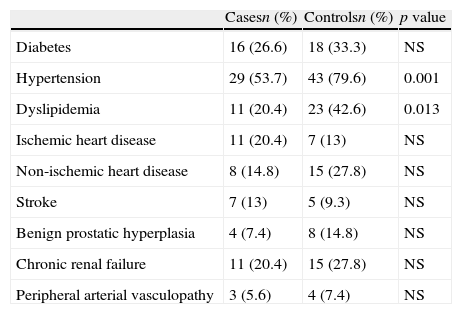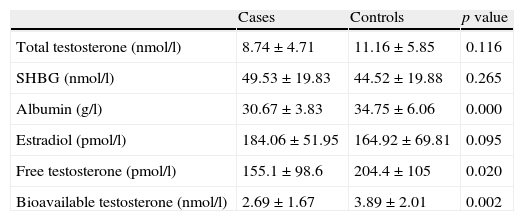Progressive loss of bone mineral density weakens the bones and increases the probability of osteoporotic fractures. It is well known that sex steroids play a role in the maintenance of bone density. This fact makes us think there might be a correlation between sex steroid levels and osteoporotic hip fractures.
Materials and methodsA case–control study was performed. The cases were 54 men who suffered from hip fracture. They were compared with 54 age-matched male control subjects. Levels of total testosterone, sex hormone binding globuline, albumin and estradiol were measured in all subjects in order to calculate free testosterone and bio-testosterone levels.
ResultsMen who suffered from hip fracture had lower serum total testosterone (8.74nmol/l vs. 11.16nmol/l; p=0.116) and lower free testostenone (155.1pmol/l vs. 204.4pmol/l; p=0.02) than control subjects. Bio-testosterone levels were lower in patients with hip fracture (2.69nmol/l vs. 3.89nmol/l; p=0.002), being the latter the best fracture predictor (OR: 1.58).
ConclusionsIn our study population, men with hip fractures had significantly lower levels of calculated free testosterone and bio-testosterone. These findings suggest that free testosterone and bio-testosterone levels are independent predictors for osteoporotic hip fracture in elderly men.
La pérdida progresiva de la densidad mineral ósea debilita los huesos y aumenta la probabilidad de fracturas osteoporóticas. Es conocida la acción de los andrógenos en el mantenimiento de la densidad mineral ósea. Este hecho nos hace pensar que podría existir una relación entre los niveles de esteroides sexuales y la fracturas osteoporóticas de cadera.
Material y métodosSe realiza un estudio caso-control, donde los casos correspondieron a 54 varones con fractura de cadera que se aparearon por edad con 54 controles varones. A todos los pacientes se les determinó niveles de testosterona total, globulina transportadora de hormonas sexuales, albúmina y estradiol para el cálculo de la testosterona libre y la testosterona biodisponible.
ResultadosLos pacientes con fractura de cadera presentaron unos niveles de testosterona inferiores a los controles (8,74 n/mol/L frente a 11,16nmol/L; p=0,116) al igual que de testosterona libre (155,1pmol/L frente a 204,4pmol/L; p=0,02). Los niveles de testosterona biodisponible fueron inferiores en pacientes con fractura de cadera (2,69nmol/L frente a 3,89nmol/L; p=0,002) siendo esta última el mejor predictor para fractura (OR: 1,58).
ConclusionesLos pacientes con fractura de cadera presentan unos niveles significativamente inferiores de testosterona libre calculada y biodisponible en nuestra población a estudio. Estos hallazgos sugieren que los niveles de testosterona libre y biodisponible son predictores independientes de fractura de cadera osteoporótica en pacientes de edad avanzada.









